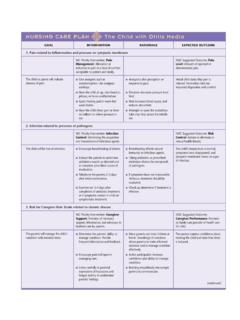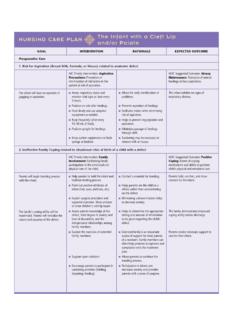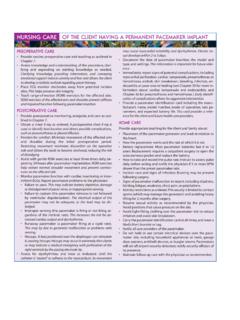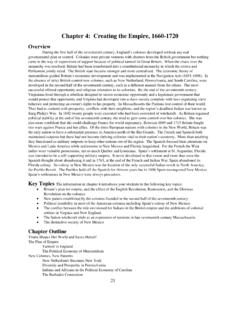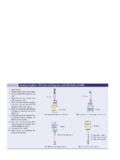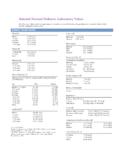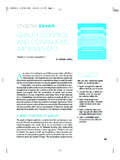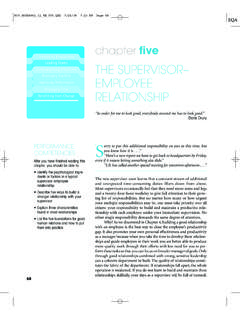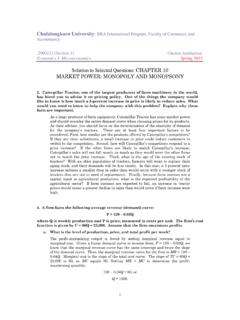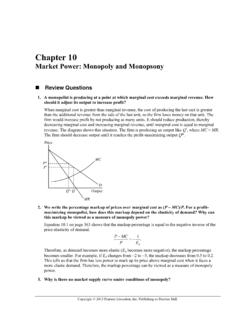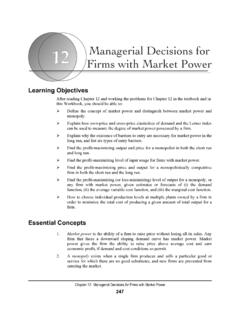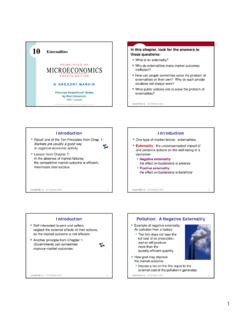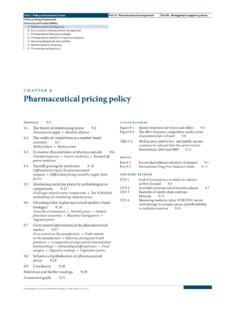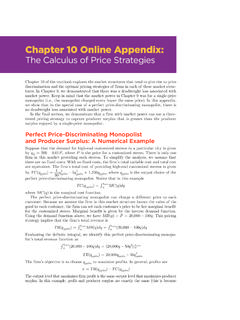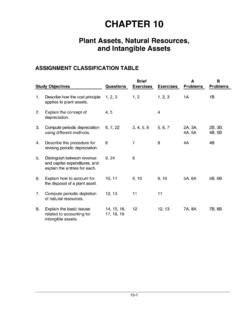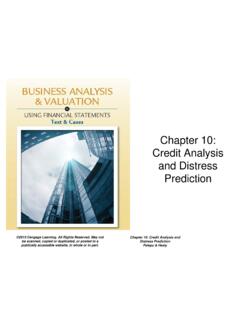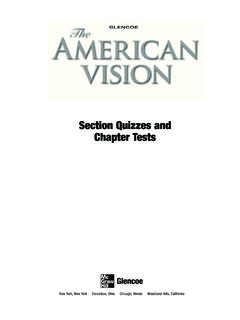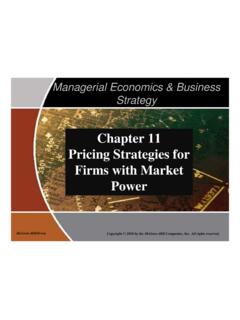Transcription of Chapter 10: The Market Revolution, 1815 - 1824
1 66 Chapter 10: The Market revolution , 1815 - 1824 OverviewFollowing the War of 1812, the American economy was altered from an economy partly dependent onimports from Europe to an economy that evolved into an empire of internal commerce. In 1817 James Monroereplaced James Madison as president of the The Republicans continued policies begun in Jefferson sadministration. With a new generation of leaders the Republican Party came to embrace the principles ofgovernment activism and the development of large-scale domestic manufacturing. Despite all of the promises thatcharacterized the United States, discrepancies loomed: the survival of slavery, treatment of the Indians, thedeterioration of some urban areas, and a mania for speculation.
2 The nation was not just growing through theaddition of land, but population shifts brought about new states to the Union and when Missouri petitioned forstatehood in 1819, the issue of slavery was thrust on the national agenda. Thomas Jefferson wrote that the issueawakened him like a firebell in the night. That the Missouri question coincided with the nation s worst financialcrisis awakened anxieties in many Americans. By the 1820 s Americans recognized a rough regional specialization:plantation-style export agriculture in the south, a north built on business and trade, and a frontier west. The regionswere interdependent but in time their differences would become more obvious, more important, and increasinglymore Topics The information in Chapter 10 introduces your students to the following key topics: Tensions between regionalism and nationalism in the republic The expansion of plantation slavery in the South The growth of wage labor and cities in the North Transcontinental politics in the United States The growth of National RepublicanismChapter OutlineCincinnati: Queen of the WestNew Lands, New MarketsWestward to the MississippiThe Transportation RevolutionThe Waltham System of ManufacturingFeature: How The Lived and Where They Worked.
3 Lowell, MassachusettsA New NationalismThe Political Economy of National RepublicanismThe United States in the AmericasJudicial NationalismFirebells in the NightThe Panic of 1819 The Missouri CompromiseThe Political Economy of RegionalismCities, Markets, and Commercial Farms in the NorthPlanters, Yeomen, and Slaves in the SouthThe River and the WestConclusionAnnotated Chapter outlineCincinnati: Queen of the West: Cincinnati symbolizes the growth of the American economy and industryfollowing the end of the War of 1812. Consumers had money to spend, shopkeepers had merchandise to sell, andjobs were plentiful. Cincinnati s location on the Ohio River placed it on a new trade route west to the MississippiRiver and the Mississippi south to the Gulf of Mexico.
4 The city looked west for opportunity as did many67 Americans. Cincinnati prospered and in the economic collapse of 1819, it suffered like other cities in the UnitedStates. Cincinnati also symbolizes the republic between 1815 and 1830: national self-sufficiency and the promise ofpersonal opportunity. The growth of internal markets reinforced a pattern of regional economic , the regions had different Lands, New Markets: Following the War of 1812, the American economy was altered from aneconomy partly dependent on imports from Europe to an economy that evolved into an empire of to the Mississippi: The biggest Market of all was in land, and the sale of land represented asteady stream of revenue for the national government.
5 However, the problem of obtaining Indian lands so it couldbe sold to settlers became the paramount question of American policy. The government had a history ofsuccessfully reducing Indian land holdings and despite promises to the contrary, the federal government continuedto take Indian lands. Acquiring land, the national government devised policies to facilitate the sale of land so that itcould have revenue from its asset. The Congress reduced the minimum number of acres it would sell from 640 acresto 320 acres, it reduced the price per acre from $ to $ and it allowed for payments over time. At the sametime, wealthy investors were also allowed to buy large tracts of land for resale. Americans moved west in drovesand the population of western states grew and western states were admitted to the Union in rapid was remarkably heterogeneous: American Indian refugees, slaves who were being forcibly relocated, aswell as white people for whom life back home offered no Transportation revolution : Westward migration and the expansion of the economy demandedunproved means of getting goods to Market and to consumers.
6 Toll-roads, generally a locally financed affair, madea poor investment. Road construction also meant bridge construction and bridges usually turned a better profit thanroads. More important was the development and improvement of steam engines to power boats. Steam poweredboats made use of the interstate highways of the Ohio, Wabash, and other rivers, especially the Mississippi economies of these regions developed and expanded. Owners and operators made profits from steam there were potentially prosperous areas where steamboat travel was not possible. The answer to this problemcould be solved by linking water routes by canals. The Erie Canal, paid for with state money, was a risky gamblethat not only paid handsome profits but also reduced the cost of transportation dramatically stimulating Waltham System of Manufacturing: By 1814 mechanics and investors had laid the groundwork forindustrial manufacturing in America.
7 The first full application of improved practices to manufacturing came tofruition after the War of 1812 through the efforts of Francis Cabot Lowell who opened the first fully mechanizedtextile mill in the United States in Waltham, Massachusetts. Much of the Waltham mills was revolutionary: thescale of its capitalization was impressive as was the way in which labor was organized. The company devised aresidential system and hired mostly young women. Not only was work changed but the workers were also most of the girl workers, this was the first time they had their own money and controlled how it was independence soon followed. Long term changes were also evident: girls who worked in the textile millsmarried later, to marry urban men, and to live in town.
8 For an example of how the Lowell girls lived and workedsee How they lived and how they worked. Was the Market revolution really a revolution ? Was it a phenomenon of local markets, regional markets,national markets--or all three? List five factors after 1800 that encouraged the growth of markets New Nationalism: In 1817 James Monroe replaced James Madison as president of the TheRepublicans continued policies begun in Jefferson s administration. With a new generation of leaders theRepublican Party came to embrace the principles of government activism and the development of large-scaledomestic Political Economy of National Republicanism: A new generation of politicians began to influence theRepublican party.
9 The Republicans did not share Jefferson s fears of a strong central government, instead theybelieved that an activist central state might be the nation s best protection against localism and dangerousfragmentation. Henry Clay (Kentucky), John C. Calhoun (South Carolina), and Daniel Webster and John QuincyAdams (Massachusetts) began to dominate the party. Although there were differences of opinion within the party,Calhoun called on Americans to endorse a policy of prosperity and greatness . The Republicans, trying torepresent the nation s regional concerns devised the American Plan for the South and West, the plan called for a68national subsidy to improve transportation; in the northeast it supported a protective tariff to safeguard industry anda new national bank to keep currency and credit stable.
10 The Congressional bills dealing with the tariff and the bankfared better than transportation subsidies. The transportation subsidy was troublesome. Not only did it askcongressmen to support plans beneficial to regions other than their own but also many, including PresidentsMadison and Monroe, questioned the constitutionality of the United States in the Americas: By 1819, the asserted territorial claims that stretched to the Pacificand it claimed diplomatic sovereignty that extended to the hemisphere. In the Rush-Bagot Treaty of 1817 the Great Britain agreed to limit military forces on the Great Lakes, establishing the precedent of an unfortifiedborder. In the Convention of 1818 the two nations agreed to a border along the forty-ninth parallel to the RockyMountains.

